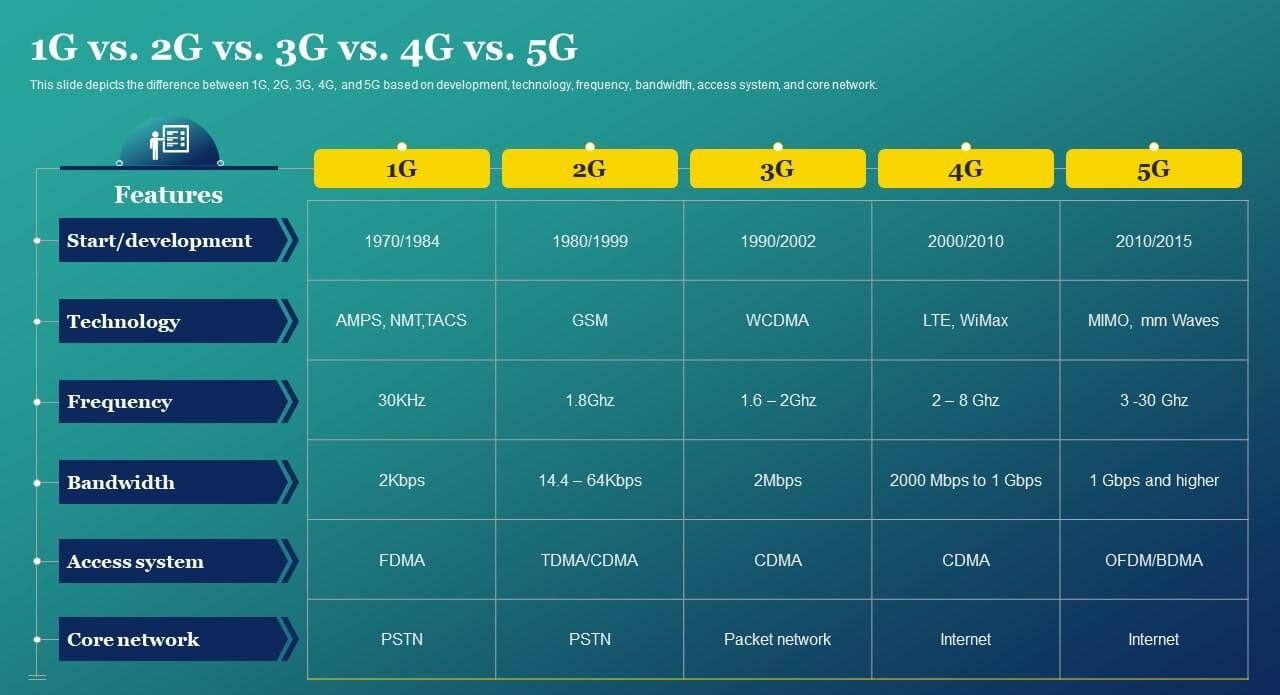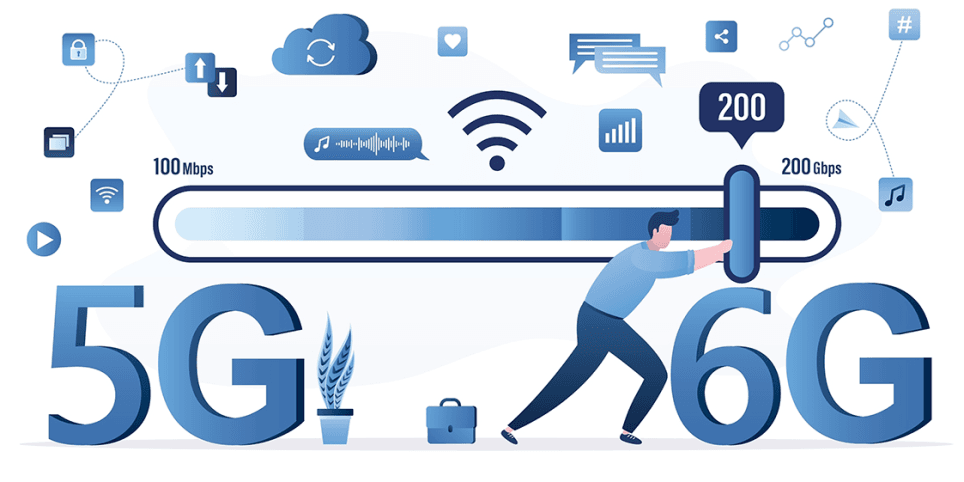Since its rollout in 2019, 5G wireless networks have been growing in both availability and use cases. Apple was one of the first manufacturers to test the appetite for 5G in 2020 by offering its newest iPhone with 5G compatibility. From there, the floodgates opened, and today as much as 62% of smartphones are built with 5G connectivity . The number of networks also continues to grow, with many popular Internet Service Providers (ISPs) like Verizon, Google and AT&T, offering 5G connectivity in both homes and businesses. 6G will the next generation of Connection.
 –Previous generations of Networks–
–Previous generations of Networks–
- First generation – 1G
1980s: 1G delivered analog voice. - Second generation – 2G
Early 1990s: 2G introduced digital voice. - Third generation – 3G
Early 2000s: 3G brought mobile data. - Fourth generation – 4G LTE
2010s: 4G LTE ushered in the era of mobile broadband.
 What is 5G?
What is 5G?
5G is a unified, more capable air interface. It has been designed with an extended capacity to enable next-generation user experiences, empower new deployment models and deliver new services. With high speeds, superior reliability and negligible latency, 5G will expand the mobile ecosystem into new realms. 5G will impact every industry, making safer transportation, remote healthcare, precision agriculture, digitized logistics — and more — a reality. It replace the previous standards of 3G, 4G and 4G LTE. Its goal was to define a new set of standards for devices and applications compatible with 5G networks. Like its predecessors, 5G uses radio waves to transmit data. However, because of improvements in latency, throughput and bandwidth, 5G networks can reach much faster download and upload speeds, giving it a much wider range of applications.
 –Benefits from 5G–
–Benefits from 5G–
- Enhanced Speed and Capacity:
5G networks are designed to deliver data speeds up to 100 times faster than 4G, enabling seamless streaming, rapid downloads, and real-time data transfer. The increased capacity allows for more devices to be connected without compromising performance, which is crucial for the growing Internet of Things (IoT) ecosystem. - Low Latency:
One of the most significant advantages of 5G is its ultra-low latency, which can be as low as 1 millisecond. This near-instantaneous response time is essential for applications requiring real-time feedback, such as autonomous vehicles and remote surgery. - Improved Reliability and Efficiency:
5G networks are more reliable and efficient, with better energy management and longer battery life for connected devices.
 Where is 5G being used?
Where is 5G being used?
- Enhanced mobile broadband:
In addition to making our smartphones better, 5G mobile technology can usher in new immersive experiences such as VR and AR with faster, more uniform data rates, lower latency, and lower cost-per-bit.
- Mission-critical communications:
5G can enable new services that can transform industries with ultra-reliable, available, low-latency links like remote control of critical infrastructure, vehicles, and medical procedures.
- Massive IoT (Internet of Things )
5G is meant to seamlessly connect a massive number of embedded sensors in virtually everything through the ability to scale down in data rates, power, and mobility—providing extremely lean and low-cost connectivity solutions.
—Trending Usages of 5G—
- Smart Cities:
5G will play a pivotal role in the development of smart cities, where interconnected devices and sensors can manage everything from traffic flow to energy consumption, enhancing urban living standards.
- Healthcare:
The healthcare sector stands to benefit immensely from 5G, with possibilities like remote surgery, real-time patient monitoring, and telemedicine becoming more feasible and reliable.
- Autonomous Vehicles:
The low latency and high reliability of 5G are critical for the safe operation of autonomous vehicles, enabling them to communicate with each other and with traffic management systems in real-time.
- Entertainment and Media:
Enhanced mobile broadband capabilities will transform the entertainment industry, offering high-definition streaming, augmented reality (AR), and virtual reality (VR) experiences on the go.
—5G to 6G—
The development of 6G is already on the horizon, promising even greater speeds, lower latency, and more sophisticated applications. While 5G is still in its early stages of deployment, its impact is already being felt, and its full potential is yet to be realized. The first 6G networks could roll out as early as 2028. By 2030, 6G is expected to be commercially available. One of the goals of the 6G internet is to support one microsecond latency communications. This is 1,000 times faster — or 1/1000th the latency — than one millisecond throughput .It is important to note that 6G is not yet a functioning technology. While some vendors are investing in the next-generation wireless standard, industry specifications for 6G-enabled network products remain years away.
 —5G vs 6G—
—5G vs 6G—
6G will have big implications for many government and industry approaches to public safety and critical asset protection, such as the following:
- Threat detection
- Health monitoring
- feature and facial recognition
- decision-making in areas like law enforcement and social credit systems
- air quality measurements
- gas and toxicity sensing
- sensory interfaces that feel like real life.
 Who is working on 6G technology?
Who is working on 6G technology?
- The University of Oulu in Finland has launched the 6 Genesis research project to develop a 6G vision for 2030. The university has also signed a collaboration agreement with Japan’s Beyond 5G Promotion Consortium to coordinate the work of the Finnish 6G Flagship research on 6G technologies.
- South Korea’s Electronics and Telecommunications Research Institute is conducting research on the terahertz frequency band for 6G. It envisions data speeds 100 times faster than 4G Long-Term Evolution (LTE) networks and five times faster than 5G networks.
- China’s Ministry of Industry and Information Technology is investing in and monitoring 6G R&D in the country.
- The U.S. Federal Communications Commission (FCC) in 2020 opened up 6G frequency for spectrum testing for frequencies over 95 gigahertz (GHz) to 3 THz.
- Hexa-X is a European consortium of academic and industry leaders working to advance 6G standards research.
- Finnish communications company Nokia is leading that project, which also includes Ericsson, a Swedish operator, and TIM in Italy.
- Osaka University in Japan and Australia’s Adelaide University researchers have developed a silicon-based microchip with a special multiplex to divide data and enable more efficient management of terahertz waves. During testing, researchers claimed the device transmitted data at 11 gigabits per second compared to 5G’s theoretical limit of 10 Gbps of 5G.
Artical written by V.Harishram















Pink Withney I do not even understand how I ended up here, but I assumed this publish used to be great